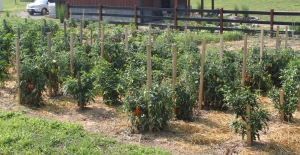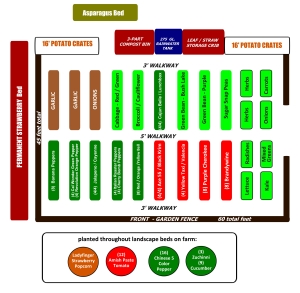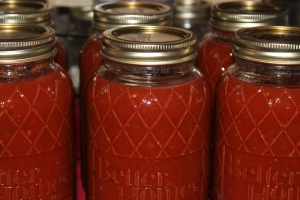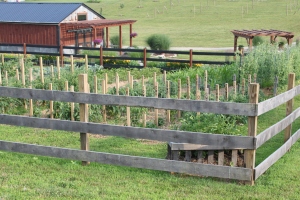2015 is here – and that means its time to turn our full attention to this year’s garden plan!
Getting the plan in order now allows us plenty of time to get our saved seeds ready – and order the ones we need to be ready to start indoors in the coming months. (see: Starting Seeds Indoors).

Our garden provides the majority of our food – so getting a good growing plan together is important.
Of more importance – it gives us the opportunity to plan out our food goals for the year – and make sure we have the plants in the garden we need to accomplish our food goals.
Whether it be fresh meals through the spring, summer and fall – or canning and preserving more for use throughout the winter months – our garden provides the majority of our family’s food throughout the year – so it’s important to get the plan right.
Rule #1 – Growing What We Love To Eat!
Our food-growing plan is rooted firmly on one basic principle – grow what our family likes to eat! It sounds so simple – but its important to make the most of our garden space and the time we spend tending it by growing what our taste buds respond to the most.
Our plan is always full of a large quantity of tomatoes, peppers, peas, cucumbers, onions and potatoes – because our family loves to eat them in all types of dishes. Fresh salads, stuffed peppers, grilled or baked potatoes and all kinds of vegetable stir fry’s are just a few of the common-place meals that we make and enjoy on a consistent basis – so that’s what we grow most!
Those same plants also make up the main ingredients of the items we can and preserve to eat the year round – such as pasta sauce, salsa, ketchup, pizza sauce, hot pepper mustard, tomato juice and more. (see: Growing A Garden For Canning)
What you won’t ever find on our plan – lima beans – for one reason or another – not one of us like them! 🙂
The 2015 Garden Plan:
Over the course of the past three years – we have switched all of the vegetable plants we grow to heirloom varieties. You simply cannot beat the taste, quality and diversity that old-time heirloom varieties bring to the table!
Tomatoes and Peppers
Cherokee Purple, Brandywine and Black Krim remain our favorites among the tomatoes. They simply burst with flavor and make for incredible pasta sauce and salsa. Also at the top are Taxi (yellow) and Valencia (orange) – not only are they prolific producers – but their flavor is simply amazing in salads or to just slice and eat. Those two varieties also are the main ingredients of THE most amazing tomato soup I have ever tasted. When Mary made it fresh last year for the first time – it was a big winner in the house! . It also freezes perfectly – making it even more valuable as a year-round food for us.
We are growing the usual staple varieties of peppers – including jalapeno, Italian roaster, green, red and yellow bell, cayenne and hot banana – but our heirloom Chinese Lantern Peppers remain our absolute favorite. They are an unbelievable blend of hot and sweet that liven up any salsa, soup or salad – but even better – when dried – they create the most amazing tasting powder that can give flavor to any dish. (see: making your own hot pepper flakes and powder)
And they are so beautiful and filled with hundreds of colorful peppers – we don’t even grow them in our garden – instead opting to grow them in our landscape beds around the farm for beautiful color from late spring to late fall.
A new way to grow our potatoes
We are both very excited how we will be growing our potatoes this year!
After the success of our potato crate experiment last year (see: The Great Potato Crate Experiment), we have expanded the crates along the entire back row of our garden to grow all of our potato varieties, including Yukon Gold, Russet, Purple and Blue finger potatoes. We will have a “how to” post coming up in a few weeks on building the crates.
Staying with the “growing what we love” theme – we will once again grow Ladyfinger and Strawberry popcorn – which has become a nightly snacking favorite. (see: how to grow popcorn)
Companion Planting and Crop Rotation
As always – we have rotated our crops from last year’s rows to help keep pests and soil borne diseases at bay. Tomatoes and peppers go from the top of the beds to the bottom – with peas, beans, onions and garlic moving back up top. We also rotate which rows we plant in from top to bottom so that a specific plant (i.e. tomato) won’t be planted in the same soil for four years.
This year – we are also experimenting a little bit with plantings of vegetables in open landscape beds around the farm to rotate even more in and out of the garden. We are using our landscape beds around the farm for growing our Amish Paste tomatoes as well as our cucumbers and zucchini, opting to place a few here and there to add color and diversity to the plantings.
We also try when possible to use the principles of companion planting to take advantage of the positive relationship between plants. In basic terms – some plants – such as corn, peas, beans and potatoes perform better when planted close to each other – and it can help with everything from growth rate, to pest resistance and soil fertility. (see: the basics of companion planting)
So there you have it – our 2015 Garden Plan – I guess its time for us to get busy ordering those seeds!
Happy Gardening! Jim and Mary
**If you would like to receive our Sunday Farm Update each week – be sure to sign up to follow the blog via email in the right hand column, “like” us on the Facebook, or follow us on Twitter.







